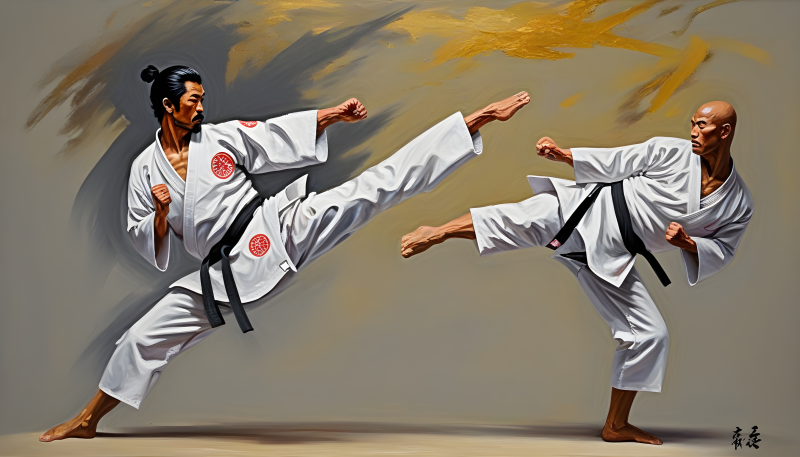
Full Contact vs. Point Fighting: A Clash of Styles in the Martial Arts Arena
The martial arts world is a vast and diverse landscape, teeming with disciplines and styles that cater to a multitude of preferences and goals. Within this spectrum, two distinct approaches to combat training and competition stand out: full contact and point fighting. These seemingly contrasting philosophies, while sharing the common thread of martial arts, offer unique experiences and cater to different aspirations. Delving into their differences can be a fascinating exploration of strategy, technique, and the very essence of combat itself.
Full Contact: Where Power Meets Pain
Full contact fighting, as the name suggests, emphasizes the delivery of controlled yet significant strikes to the opponent. This approach prioritizes power, speed, and accuracy, with the goal of physically affecting the opponent and potentially ending the fight through knockouts or technical knockouts. Punches, kicks, and sometimes throws are all fair game, with varying degrees of force permitted depending on the specific style and ruleset.
The training regime for full contact fighters is grueling and demanding. It involves intensive physical conditioning, honing striking and grappling techniques, and developing mental toughness to endure pain and withstand the intensity of combat. Sparring sessions are often brutal affairs, testing fighters' ability to take and deliver punishment while maintaining focus and strategy.
The appeal of full contact lies in its visceral nature. It offers a closer simulation of real-world combat, where strikes have real consequences and the potential for injury is ever-present. This element of danger, however, is strictly controlled by regulations and protective gear, ensuring the safety of participants while still preserving the raw energy and excitement of full-on fighting.
Point Fighting: A Dance of Precision
Point fighting, on the other hand, takes a more controlled and technical approach to combat. The focus shifts from delivering powerful strikes to scoring points through precise, controlled techniques that land clean on designated target areas. Points are awarded for kicks, punches, and sometimes sweeps, depending on the specific ruleset, with the fighter with the most points at the end of the match declared the victor.
Training for point fighting emphasizes speed, agility, and tactical awareness. Fighters hone their reflexes, footwork, and timing to land scoring techniques while evading their opponent's attacks. Sparring sessions are characterized by rapid exchanges of strikes, often resembling a intricate chess match where every move is calculated and countered.
The appeal of point fighting lies in its emphasis on skill and precision. It demands a deep understanding of the rules, timing, and control, rewarding fighters for their technical mastery and tactical ingenuity. Moreover, the controlled nature of the competition minimizes the risk of injury, making it a safer option for individuals who prioritize technical development over full-contact sparring.
Beyond the Binary: A Spectrum of Approaches
While full contact and point fighting seem like distinct entities, the martial arts world is rarely black and white. Many disciplines and styles incorporate elements of both approaches, creating a spectrum of training methods and competition formats. For example, Muay Thai, a brutal striking art, incorporates controlled point-scoring rounds in some competitive settings. Conversely, point-fighting styles like Olympic Taekwondo are slowly incorporating elements of light contact sparring to increase the realism and effectiveness of training.
Ultimately, the choice between full contact and point fighting comes down to individual preferences and goals. Some individuals may be drawn to the raw power and intensity of full contact, while others may prefer the controlled precision and technical focus of point fighting. Both approaches offer valuable avenues for physical and mental development, instilling discipline, respect, and strategic thinking.
Beyond the Competition: The Shared Essence of Martial Arts
Regardless of the chosen path, whether the roar of the crowd fuels your strikes or the satisfaction of a well-executed technique drives you, both full contact and point fighting share the core values of martial arts. They promote physical fitness, mental discipline, and a deeper understanding of self-defense. They foster respect for oneself, one's opponent, and the tradition of martial arts.
In the end, the differences between full contact and point fighting are but surface-level variations within the vast tapestry of martial arts. Beneath the surface, both approaches share a common thread: the pursuit of self-improvement, the exploration of combat, and the dedication to the art of self-defense. So, whether you choose the thunderous path of full contact or the intricate dance of point fighting, remember that the true journey lies within, a journey of self-discovery and growth through the pursuit of martial excellence.
Add comment
Comments